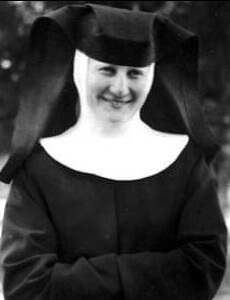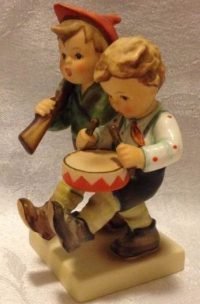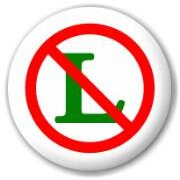May 21 is Sister Maria Hummel Day

Sister Maria Innocentia Hummel
Today is Sister Maria Hummel Day which celebrates the birth in 1909 of Berta Hummel, a German girl whose family recognized and encouraged her developing artistic talent from early childhood.
She entered Munich’s Academy of Applied Arts in 1927, at a time when few German women were able to pursue higher education. After graduating in 1931 with top honors, she chose to become a nun in the Congregation of the Franciscan Sisters of Siessen and assumed the name of Sister Maria Innocentia.
She taught art at a school run by the convent and painted in her spare time. When the sisters noticed her portraits of children, they convinced her to let a religious publishing company print and sell them as postcards. Hummel later drew angels with gowns covered in slightly askew Stars of David and designed a symbol for the convent chapel in 1938 that united the Old and New Testaments by placing a cross behind a menorah.
In 1934, Franz Goebel, the owner of W. Goebel Porcelain Works, saw some of the postcards and was struck with the idea of rendering them in three dimensions. He approached Hummel, who didn’t want her work mass-produced as knickknacks. She acquiesced at the insistence of the convent, which gave Goebel sole rights to manufacture the figurines. Royalties from sales would help finance its good works for 80 years.
Goebel displayed them at the 1935 Leipzig Trade Fair, an international trade show. Goebel had rightly surmised that people weary of poverty and war would be attracted to sweet and innocent figurines of boys, girls, and angels. Ten years later, American soldiers would carry them home after World War II and make them popular in the United States as well.
One person who was most definitely not a fan of Hummel: Adolf Hitler. In 1937, she released a painting titled “The Volunteers,” which depicted two young, disheveled goose-stepping brownshirts with laceless boots, one of whom carried a rifle upside down. Under them, she wrote the caption, “Dear Fatherland, let there be peace!”
Nazi newspaper Der SA-Mann declared that the children Hummel painted looked like “wasserköpfige und klumpfüßige Dreckspatzen,” which loosely translates to “hydrocephalic, club-footed goblins.” Although a more literal translation would be “water-headed, club-footed mudlarks,” we think you get the idea.
The sale of Hummel figurines was banned within Germany, but export was permitted to generate profits from foreign markets. Her publishers were denied paper supplies; galleries were forbidden to exhibit her paintings. In 1940, the sisters were kicked out of the convent so a troop of Nazi soldiers could quarter there.

Volunteers, 1990
Forty of the 250 nuns were allowed to remain in a confined area with no heat. After three months at her childhood home, Hummel decided to return, with the blessing of the Mother Superior. Money earned from the sale of her artwork was the convent’s sole source of income.
In 1944, she contracted tuberculosis and was sent to a sanatorium for several months. Shortly after she returned, French troops liberated the convent. But her health worsened and she died on November 6, 1946, at the age of 37. She was buried on the convent grounds.
Although we can find no surviving print of “The Volunteers,” the story of Sister Hummel’s most provocative artwork did not end after her death. In 1990, the rifle was righted, the shirt color changed and her sad boys were cast, without irony, as cheerful patriots for a United States Desert Storm Edition.
We’re pretty sure Sister Maria Hummel would disapprove of that knickknack.
![]()









Leave a Reply
Want to join the discussion?Feel free to contribute!